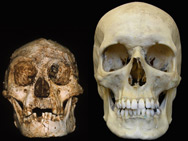http://abcnews.go.com/Technology/story?id=198867&page=1
ABC NewsBy Amanda Onion
Oct. 27, 2004 ?
Once upon a time, on an isolated island of Indonesia, there lived a colony of little people ? very little people.Not only did anthropologists find the skeletal remains of a hobbit-sized, 30-year-old adult female, in this fairy-tale-like discovery they also uncovered in the same limestone cave the remains of a Komodo dragon, stone tools and a dwarf elephant.
Subsequent finds of other similarly sized, 3-foot-tall humans with brains the size of grapefruits in a cave on the Indonesian island of Flores suggest these 18,000-year-old specimens weren't a quirk of an ancient hominin, but part of an entire species of miniature people whose existence overlapped with that of modern Homo sapiens.
"We now have the remains of at least seven hobbit-sized individuals at the cave site, so the 18,000-year-old skeleton cannot be some kind of 'freak' that we just happened to stumble across first," said Bert Roberts, an anthropologist at the University of Wollongong in New South Wales, Australia, and co-author of the study about the find in this week's issue of the journal "Nature."
Peter Brown, lead researcher of the study and an anthropologist at the University of New England in Armidale, Australia, says that although modern humans had reached Australia by 45,000 years ago, so far there's no evidence suggesting the small species of human and modern humans ever met.
Still, another author, Mike Morwood, also of the University of New England, says because the two existed in the same general region for nearly 30,000 years, "It is certain that they came face to face on occasion."
Island Adaptation
Although the odd little humans likely left no descendants, and therefore no mark on modern human biology, the scientists say this is the first documentation of the entirely new species of hominins that apparently adapted and lived for thousands of years in caves on the isolated island. As for their size, their limited habitat and its hot, humid conditions may have been key factors.
Brown and the other authors suggest that the newly found species, named Homo floresiensis, arrived on the island of Flores, in Indonesia's Nusa Tenggara region, in the form of Homo erectus, the first large-brained hominin that emerged some 2 million years ago in Africa and Asia.
